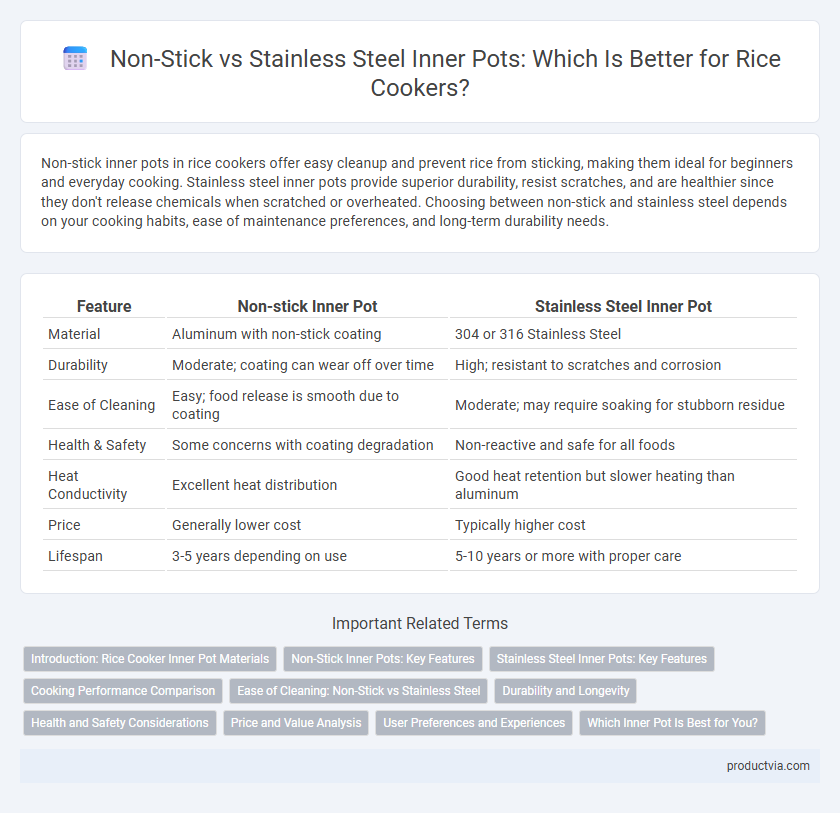Non-stick inner pots in rice cookers offer easy cleanup and prevent rice from sticking, making them ideal for beginners and everyday cooking. Stainless steel inner pots provide superior durability, resist scratches, and are healthier since they don't release chemicals when scratched or overheated. Choosing between non-stick and stainless steel depends on your cooking habits, ease of maintenance preferences, and long-term durability needs.
Table of Comparison
| Feature | Non-stick Inner Pot | Stainless Steel Inner Pot |
|---|---|---|
| Material | Aluminum with non-stick coating | 304 or 316 Stainless Steel |
| Durability | Moderate; coating can wear off over time | High; resistant to scratches and corrosion |
| Ease of Cleaning | Easy; food release is smooth due to coating | Moderate; may require soaking for stubborn residue |
| Health & Safety | Some concerns with coating degradation | Non-reactive and safe for all foods |
| Heat Conductivity | Excellent heat distribution | Good heat retention but slower heating than aluminum |
| Price | Generally lower cost | Typically higher cost |
| Lifespan | 3-5 years depending on use | 5-10 years or more with proper care |
Introduction: Rice Cooker Inner Pot Materials
The rice cooker inner pot primarily comes in two materials: non-stick and stainless steel, each offering distinct benefits. Non-stick inner pots provide easy cleaning and prevent rice from sticking, improving convenience in daily use. Stainless steel inner pots offer superior durability and resistance to scratches, appealing to users who prioritize long-term maintenance.
Non-Stick Inner Pots: Key Features
Non-stick inner pots in rice cookers offer superior food release and easy cleaning due to their coated surface, reducing the risk of rice sticking or burning. These pots often feature durable coatings like Teflon or ceramic, providing even heat distribution and enhancing cooking performance. Their lightweight design and resistance to scratches make non-stick inner pots a convenient and practical choice for everyday rice preparation.
Stainless Steel Inner Pots: Key Features
Stainless steel inner pots in rice cookers offer exceptional durability and resistance to scratches, corrosion, and high temperatures, ensuring long-lasting performance. They provide even heat distribution for consistent cooking results and are easy to clean without requiring special care. Unlike non-stick coatings, stainless steel is free from chemicals, making it a safer and more hygienic option for cooking rice.
Cooking Performance Comparison
Non-stick inner pots provide even heat distribution and prevent rice from sticking, resulting in softer, more evenly cooked grains ideal for everyday use. Stainless steel inner pots offer superior durability and better heat retention, delivering a slightly firmer texture with a natural cooking finish preferred by culinary enthusiasts. Both materials influence cooking performance, with non-stick excelling in ease of cleaning and stainless steel excelling in long-term resilience and flavor preservation.
Ease of Cleaning: Non-Stick vs Stainless Steel
Non-stick inner pots offer superior ease of cleaning due to their smooth coating that prevents rice from sticking, requiring minimal scrubbing and reducing residue build-up. Stainless steel pots are more durable and resistant to scratches but often necessitate more vigorous cleaning to remove stuck-on rice and stains. Choosing between non-stick and stainless steel inner pots balances convenience in cleaning with long-term durability and maintenance considerations.
Durability and Longevity
A non-stick inner pot in rice cookers offers easy cleaning but tends to wear down faster due to scratches and coating degradation, reducing its overall durability. Stainless steel inner pots excel in longevity, resisting scratches, dents, and corrosion, making them ideal for long-term use. Choosing stainless steel ensures reliable performance over years, while non-stick pots may require more frequent replacement.
Health and Safety Considerations
Non-stick inner pots in rice cookers offer easier cleaning and reduced oil usage, but concerns persist regarding the potential release of harmful chemicals like PFOA at high temperatures. Stainless steel inner pots provide a safer alternative by eliminating chemical coatings, ensuring durability and resistance to corrosion without compromising food safety. Choosing a stainless steel inner pot reduces the risk of toxic exposure, making it a preferred option for health-conscious consumers.
Price and Value Analysis
Non-stick inner pots for rice cookers typically cost less upfront and offer convenient easy cleaning, making them attractive for budget-conscious buyers seeking practicality. Stainless steel inner pots, while pricier initially, provide superior durability and resistance to scratches and wear, which can translate into longer-lasting value and fewer replacements over time. Evaluating total cost of ownership, stainless steel models may deliver better long-term value despite higher price points due to their robustness and consistent cooking performance.
User Preferences and Experiences
Users often prefer non-stick inner pots for rice cookers due to their easy food release and straightforward cleaning process, which enhances convenience during everyday use. Stainless steel inner pots appeal to those who prioritize durability and resistance to scratches or dents, offering long-term performance without coating degradation. Experience indicates that non-stick pots excel in preventing rice from sticking, while stainless steel pots provide a sturdier cooking environment preferred by users concerned with health and metal sensitivity.
Which Inner Pot Is Best for You?
Non-stick inner pots in rice cookers offer easy cleanup and prevent rice from sticking, ideal for quick meals and low-maintenance cooking. Stainless steel inner pots provide superior durability, even heat distribution, and are safer for high-temperature cooking, making them suited for long-term use and health-conscious consumers. Choosing the best inner pot depends on your cooking habits, preference for ease of cleaning versus longevity, and desired cooking performance.
Non-stick inner pot vs stainless steel inner pot for rice cookers Infographic

 productvia.com
productvia.com